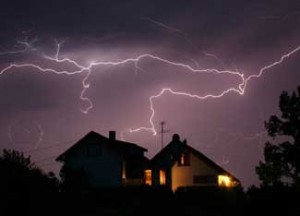Severe weather in the form of powerful electricity and heat make lightning doubly dangerous.
Some people love a great thunderstorm; others are petrified by the first flash of lightning or rumble of thunder. Love ’em or hate ’em, thunderstorms produce lightning that is dangerous. But there are easy steps you can take to protect your home and property (and your life) from lightning.
Avoid using landline telephones and water (showering, washing your hands or dishes)during a storm. Electricity follows wiring and metal pipes, but water also conducts electricity so you could be electrocuted if you’re touching water.
Protect Electronics from Severe Weather
If lightning hits your house or nearby power lines, it can follow the wiring or phone lines into your home — ruining computers, TVs, stereos and other electronics. Your homeowner’s insurance may or may not cover damage from lightning. But one safeguard against electronics being “fried” by lightning is simply to unplug them whenever you’re expecting rain or a storm. Disconnect Internet, antenna and satellite-dish connections, even if your TV antenna is grounded (connected to the Earth by metal wires or cables so electricity has a quick path to the soil).
Surge protectors help protect equipment from power spikes (and distant lightning strikes that hit the electrical grid). But nearby lightning is so powerful it can jump through surge protectors. It’s been known to jump across an entire room (called side-flashing). When this happens, anything — or anyone — in its path could be in danger.
Reduce the Risk of Fire
You might want to consider protecting an entire building. Lightning rods protect a building from catching fire, not from electrical surges. They don’t increase or decrease the chance of lightning striking your house; they just provide a path for the electricity to reach the ground more safely. The rods at the top of the building are only the first part of a good system. Lightning hits the rods (instead of the building itself) because they’re higher than other points on the building. But when lightning strikes, the electricity needs to move to the ground. Cables conduct electricity from the lightning rods to the ground stakes (buried metal rods), and each connection must be secure so lightning doesn’t jump to the building. Lightning rods are not 100 percent effective in eliminating fires from lightning, but they reduce the likelihood of a lightning strike igniting the building.
Understand Lightning
When lightning hits the ground, a tree, a tower or even a building, it doesn’t go straight down but usually spreads along the ground first, so being near something that’s struck by lightning is almost as dangerous as being hit directly by lightning. And it can strike the same place twice: The Empire State Building is struck by lightning about 100 times each year. (It actually functions as a lightning rod for surrounding buildings.)

